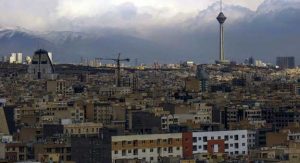
Laban Munsaka of Pemba District in Southern Province, farm is impacted by El Nino climate-induced prolonged dry spell. Credit: Friday Phiri/IPS
By Friday Phiri
LUSAKA, May 8 2024 – For most families in Zambia, April is traditionally a month of plenty—it is typically the beginning of a harvest season for various food and cash crops. Both fresh and dried maize, groundnuts, pumpkins, and a whole variety of both traditional and exotic food crops are usually in full supply and readily available for consumption, supporting household food security and nutrition.
Similarly, during this period, most families’ income levels tend to be high and sound, supportive of family demands ranging from school fees to health care and grocery needs, as they sell various cash crops. It is, in summary, the beginning of the crop marketing season and a period of positive expectations.
This farming season, however, the story of millions of households, including that of Laban Munsaka of Pemba District in Southern Province, is gravely depressing. Munsaka’s family is part of the over six million people from over a million households in Zambia estimated to be facing acute food shortages and possible malnutrition until the next growing season, which is twelve months away.
Due to the El Nino climate-induced prolonged dry spell, half of the estimated 2.2 million hectares of maize planted in the 2023–24 farming season have been destroyed. According to Zambia’s President, Hakainde Hichilema, the debilitating dry spell lasted for more than five weeks at a time when farmers needed rain the most.
“In view of these challenges, urgent and decisive action is required from all of us,” Hichilema said in his address when he declared the situation a disaster and national emergency, earlier in March 2024. “The government, in accordance with the Disaster Management Act No. 13 of 2010, and other relevant legislation, declares the prolonged dry spell a national disaster and emergency,” he said, adding that the prolonged dry spell had affected 84 of the country’s 116 districts, negatively impacting more than a million farming households.
“It’s really difficult to compare last season to what has happened this farming season,” Munsaka narrates. “I harvested 100 by 50kg bags of maize last season but I don’t know what we might get from this destroyed field, it is just zero work this season,” he laments, pointing at his destroyed maize crop field.
With a relatively huge family of over 20 members to support, Munsaka is not only worried about the eminent food insecurity but also nutrition and other health-related challenges that may likely emerge from poor nutrition intake.
“I have a bigger family,” he says. “As you know, in such situations, our focus is only on food availability. Our focus is survival. We don’t usually care about the nutrition component.”
With dwindling pasture for grazing and expected water scarcity for livestock, animal welfare is likely to be compromised, leading to possible disease outbreaks such as nutritional anthrax, putting at risk both animal and human populations.
In a climate-induced drought environment, Munsaka’s worries about food insecurity, reduced nutrition options and eminent health challenges may not be far-fetched. There is increasing scientific evidence indicating how climate change is, and continues to significantly impact the physical, biological, and mental health of individuals.
According to the Intergovernmental Panel on Climate Change’s (IPCC) sixth assessment report (AR6), climate-related illnesses, premature deaths, malnutrition in all its forms, and threats to mental health and well-being are increasing.
For example, scientific evidence indicates that dwindling water security is leading to rising cases of waterborne diseases and an overall collapse of sanitation and hygiene, while frequent and intensified droughts and floods are said to be contributing to loss of agricultural productivity, leading to food insecurity and subsequently malnutrition.
Similarly, science experts are pointing fingers at rising temperature conditions as a contributing factor to the expansion of vector-borne diseases such as malaria and dengue fever into higher altitudes and previously colder regions of the world.
The World Health Organization (WHO) estimates that if urgent interventions to tame climate change are not implemented, approximately 250,000 additional deaths per year could be recorded from malnutrition, malaria, diarrhea, and heat stress alone. This is in addition to estimated economic losses of USD 2-4 billion per year by 2030.
While the situation is as dire as described, health is not part of the mainstream agenda of climate negotiations at global level.
It is worth noting, however, that there have been efforts at the global and regional levels to address the impacts of climate change on health. At COP26 in Glasgow, the health community reached an important milestone in bringing human health at the forefront of climate change work.
For the first time in the UNFCCC negotiations, a health programme was promoted, led by the UK government as the President of COP26, the World Health Organization (WHO), Health Care Without Harm (HCWH) and the UNFCCC Climate Champions.
Two of the programme’s key initiatives were to support countries in developing climate resilient and low carbon sustainable health systems, with countries announcing their commitments to develop and invest in climate resilient and low carbon sustainable health systems and facilities.
Since COP26, Amref Health Africa, working with WHO and other partners, has been leading climate and health efforts, culminating into the first ever Health Day dedicated to health issues at COP28, at which stakeholders made further commitments in a health declaration.
As parties prepare for the UNFCCC 60th session of the Subsidiary Bodies (SB60) in Bonn, Germany, next month, the health community is also gearing to continue playing an active role in the negotiations.
“This is the time to seize the growing momentum across the globe, on the need to pool resources, knowledge, and creativity towards a forward-looking climate and health agenda to respond not only to the challenges of today but also anticipate the challenges of tomorrow,” says Desta Lakew, Amref Health Africa Group Director for Partnerships and External Affairs. “We must encourage and foster collaborations across disciplines, including environmental science, public health, epidemiology, economics, and social sciences, to address the multifaceted nature of climate change impacts on health.”
Based on this call, Amref Zambia is actively engaging the Ministry of Green Economy and Environment (MGEE) on the intersectionality of climate change and health, in view of not only the current situation but also future circumstances likely to emerge from the negative effects of climate change on the health sector.
Amref Zambia Country Manager, Viviane Sakanga, expresses delight at the opportunity to engage and Amref’s desire to collaborate on key climate and health interventions for better health outcomes amid the climate crisis.
“Evidence is abounding on how climate change is affecting health. It is for this reason that we believe, and have included the climate crisis as a key social determinant and driver of change in our 2023–2030 Corporate Strategy. We are keen to collaborate on climate and health,” said Sakanga when she recently met with the Director of Green Economy and Climate Change at the Ministry, Ephraim Mwepya Shitima.
On his part, Shitima welcomed Amref’s patronage and pledged the department’s readiness to work with like-minded institutions for meaningful climate action at all levels and in all sectors.
Ephraim Mwepya Shitima said, “it may interest you to know that Zambia identified the health sector for climate intervention as early as 2007. In implementing Article 4.9 of the Climate Convention, the COP in 2001, established the Least Developed Countries (LDC) work programme that included the National Adaptation Programmes of Action (NAPAs) to support LDCs to address the challenge of climate change given their particular vulnerability. In 2007, Zambia identified health as one of the priority sectors that required support under this work programme. Equally, the National Adaptation Plan (NAP), which was submitted last year also highlights health as a priority sector. We are therefore delighted and welcome your active involvement in the climate change and health action space.”
Amidst all, Munsaka and other millions of Zambians affected by the current and future climate-induced challenges are yearning for holistic support interventions focused not only food availability but also nutrition and health.
With the situation already declared a disaster by the Republican President, government and stakeholders continue to seek for integrated interventions.
Note: The author is Climate Change Health Advocacy Lead at Amref Health Africa
IPS UN Bureau Report







